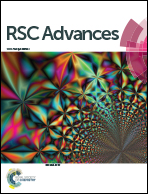Novel super-toughened bio-based blend from polycarbonate and poly(lactic acid) for durable applications
Abstract
High-performance bio-based polycarbonate (PC) and poly(lactic acid) (PLA) blends are created using poly(ethylene-n-butylene-acrylate-co-glycidyl methacrylate) (EBA-GMA) as a reactive compatibilizer and impact modifier, with the aid of an epoxy-based chain extender (CE). It is found that the use of a specific acrylic impact modifier and a high blending temperature are the major factors in reaching high toughness and superior heat resistance. Toughened blends containing 32 wt% of biosourced PLA showed impact strength and heat resistance comparable to that of neat PC, while exceeding the mechanical properties of PC. Atomic force microscopy (AFM) studies have shown that an EBA-GMA phase was concentrated exclusively within a brittle PLA phase, ensuring high-efficiency impact-strength modification with a relatively small amount of modifier. As little as 6 wt% of EBA-GMA in a PC/PLA blend was enough to increase the toughness by more than 10 times. It is found that PLA and PC phases form a co-continuous morphology in the blend, allowing it to reach a high heat resistance that is almost unaffected by an impact modifier content of up to 10 wt%. It is shown that targeted toughening of the brittle PLA phase allows the achievement of excellent mechanical properties due to a lower required acrylic rubber content. A significant bio-based content in the PC/PLA blend allows increased sustainability of manufacturing and opens possibilities for use in a wide range of industrial applications.


 Please wait while we load your content...
Please wait while we load your content...